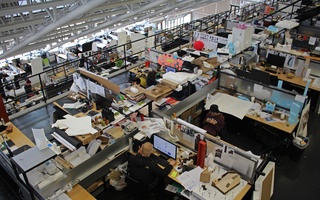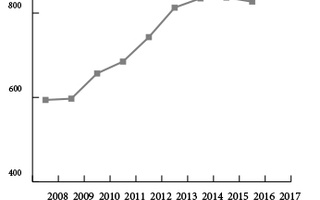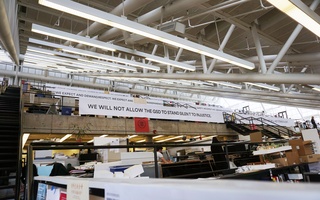Zaneta H. Hong, lecturer in landscape architecture, calls the central studio in Gund Hall the “heart” of the Harvard Graduate School of Design, and for someone regarding the space for the first time, the description holds true. The space is dominated by a five-tiered collection of desks, each one designated for a specific graduate student’s personal use. A clear span roof and large windows let in rays of light that seem to emphasize the concept of the studio as the core of design education.
{shortcode-03e08eec978a0d7d313844e6e84155edec6bd90a}
Behind the central studio, however, a much smaller, much less formidable space serves as a classroom for a small group of students. This is the HILT Room, a new space at GSD meant to revolutionize how design is taught. The acronym refers to the group that funded the space: the Harvard Initiative for Learning and Teaching. While it is located in Gund Hall, the HILT Room primarily serves undergraduates—specifically, those pursuing the new architecture studies track in the History of Art and Architecture Department.
Established in 2012 and administered by both the HAA Department and GSD, the architecture studies track is itself divided into two branches: history and theory, and design studies. The former emphasizes the study of the history of architecture; the latter, contemporary theories and applications of design. K. Michael Hays, a professor of architectural theory and associate dean for academic affairs at GSD, believes that the establishment of the architecture studies track filled a conspicuous gap in the liberal arts curriculum at Harvard. “[The HAA Department and GSD] have often talked about how disappointing it was that Harvard, who has one of the strongest and progressive liberal arts curriculum, never saw architecture as a liberal arts pursuits,” Hays says.
Still, Hays admits, the nature of architecture as an academic discipline makes it difficult to teach in the non-pre-professional context of a liberal arts college. “Because architecture has a very technical dimension, to teach it as a liberal arts study requires a little more effort,” he says. To address this challenge, the track forged a unique connection with the GSD. “What we decided was that by doing a jointly administered program, we would bring the expertise of both departments to bear.”
Students and faculty members associated with the track acknowledge that close ties to a profession, as well as to the pre-professional program at GSD, make it difficult for the program to strike a balance between the academic study of architecture and its technical application. But the achievements of the fledgling track suggest that the struggle yields success. Since its establishment, the program has provided a niche for students whose interest in architecture had previously been unaddressed by the college, and has served as a frontier for the promotion of a philosophy that seeks to broaden people’s ideas about the scope and application of architectural knowledge.
OFFICE SPACE
At just three years old, Harvard’s architecture studies track is quite young compared to those at most other institutions. Two T-stops away in Kendall Square, the MIT School of Architecture and Planning boasts five tracks within its undergraduate Bachelor of Science in Architecture program. The five-year Bachelor of Architecture program for undergraduates at Carnegie Mellon is accredited by the National Architectural Accrediting Board. These undergraduate architecture programs all feature a studio component—the aspect of Harvard’s architecture studies track that sets it apart from the rest of the HAA Department.
In addition to architecture-related classes in the HAA Department, both branches of the track require students to take two architecture studio courses at GSD: Architecture Studio 1: “Transformations” and Architecture Studio 2: “Connections.” But Professor Hong is adamant that studio courses do not a pre-professional program make. “It’s just meant to give a very enlightened preview of what an architecture program should be,” she says.
The logistics seem to support Hong’s opinion; the studio courses required by the architecture studies track only meet for six hours per week—half the time of most studio courses at GSD and of those at most nationally accredited undergraduate programs.
Hong, who teaches “Transformations,” says the studio utilizes diagrams and models to help students acquire a perspective crucial for understanding design. “Transformations” is really about developing certain knowledge and language that’s found in architecture,” Hong says. “The way that we do this is through visualization…. A lot of the products that you see from the studio are a lot of physical models, and these physical models are meant to engage a lot of larger architectural concepts—pattern, density, flow.”
According to Hong, the studio courses also provide students with the opportunity to learn the language, the terminology, and the methodology of architectural design. In her opinion, this kind of knowledge provides a solid foundation for a career in architecture, if it is what the student wants, but is by no means valuable only for this purpose.
Jeremy Ficca, an associate professor of architecture at Carnegie Mellon’s School of Architecture, agrees that studio time is essential to understanding architecture on a technical as well as a theoretical level. “[Studio work] begins to establish a way and an instrument to address ideas through the design process. Quite literally, the students are working on projects that become the vehicle to explore ideas,” Ficca says. “The studio is generally understood as being the backbone...the place through which you can...bring what you’re learning in other classes to bear on the ideas that you’re exploring in the design studio.”
For Alaina R. Murphy ’14, the required studio classes were the highlight of the track. “[Studio class] was the defining thing that made it architecture studies instead of HAA,” she says. “I personally wish I had time to do more [studio classes], and I wish there were more offered. One [class that I took] was a construction studio—we were in the GSD and physically making things every week…. We had to use computer software and our own drawings, and in the end we had to produce a structure. We got to use tools, use our hands, and that was something really special.”
Stella Fiorenzoli ’15 would also have welcomed more studio time. “I love to make things, I love to draw, I love the hands-on experiences,” she says. “That ability to go to the GSD and make those things has been met by Harvard negatively. It’s taken as being too pre-professional, but I wish we had more of those experiences.”
Read more in Arts
Fall TV PreviewRecommended Articles
-
New GSD Program Aims To Get More ArchitectsBritish-based architectural firm RMJM recently donated $1.5 million to Harvard’s Graduate School of Design (GSD) in an attempt to increase
-
 Calvin Klein Shares Perspective on Design at GSD
Calvin Klein Shares Perspective on Design at GSD -
 Design School Building Draws Praise, Except For the Desk Space
Design School Building Draws Praise, Except For the Desk Space -
 Graduate School of Design's Enrollment Soars Skyward
Graduate School of Design's Enrollment Soars Skyward -
 Female Faculty at GSD Sign Statement Against Sexual, Racial Misconduct
Female Faculty at GSD Sign Statement Against Sexual, Racial Misconduct













